This morning I threw my toothbrush into the toilet. That’s where it belongs, apparently, since I can’t seem to do the right thing to keep germs off of it.
See, a few years ago there was a big news story about the aerosols that are created with every toilet flush. I call this phenomenon “Fecal Fallout.” Let me explain: if a toothbrush is stored in the open air near a toilet, the debris from the bowl can be carried into the air and then sprinkled down onto anything within a six foot radius in a plume of doom. As a result, we may find ourselves brushing with the e.coli germs from feces if we’re not keeping our toothbrushes covered.
So if we’ve been keeping them covered, that’s not good either? Covering causes yet ANOTHER PROBLEM:
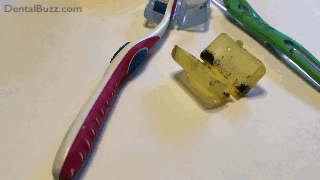
The growth that you see in this and the following image was accelerated by a few days, but this is really what happens! If we close in the moisture on our toothbrushes, we might as well invite a whole slimy rainforest to grow in there. It’s not just our toothbrushes that are being over-helicoptered. Mouthguards also tend to grow things on them if left unattended:
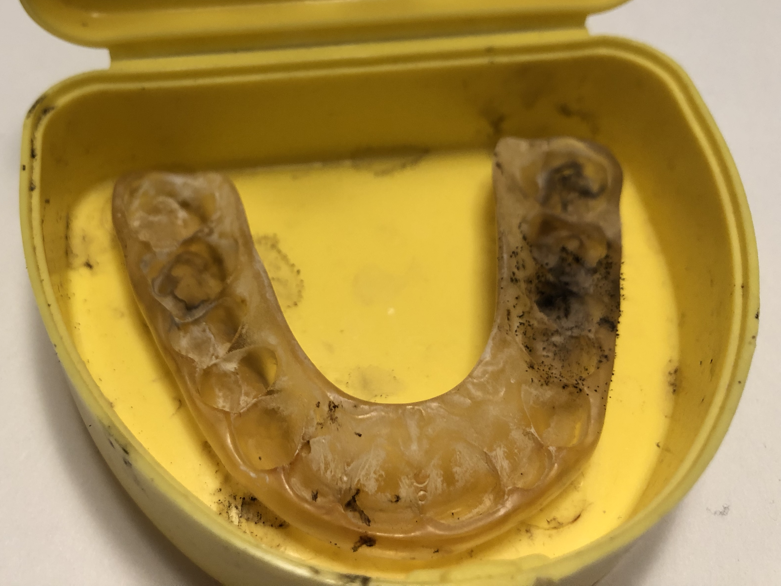
Nope. No way. I welcome the Demons Of TMJ Disturbance to visit me and make me dream about my teeth falling out all night. Sad that I’d rather grind myself down to gummy nubs than to have to clean that nightguard off and sleep in it again.
When someone tries to gross us out with a problem, there’s a reason behind it, because there must be an answer, a solution to the horrible thing that we want to prevent. What I like is that this solution happens to be quite economical and user-friendly.
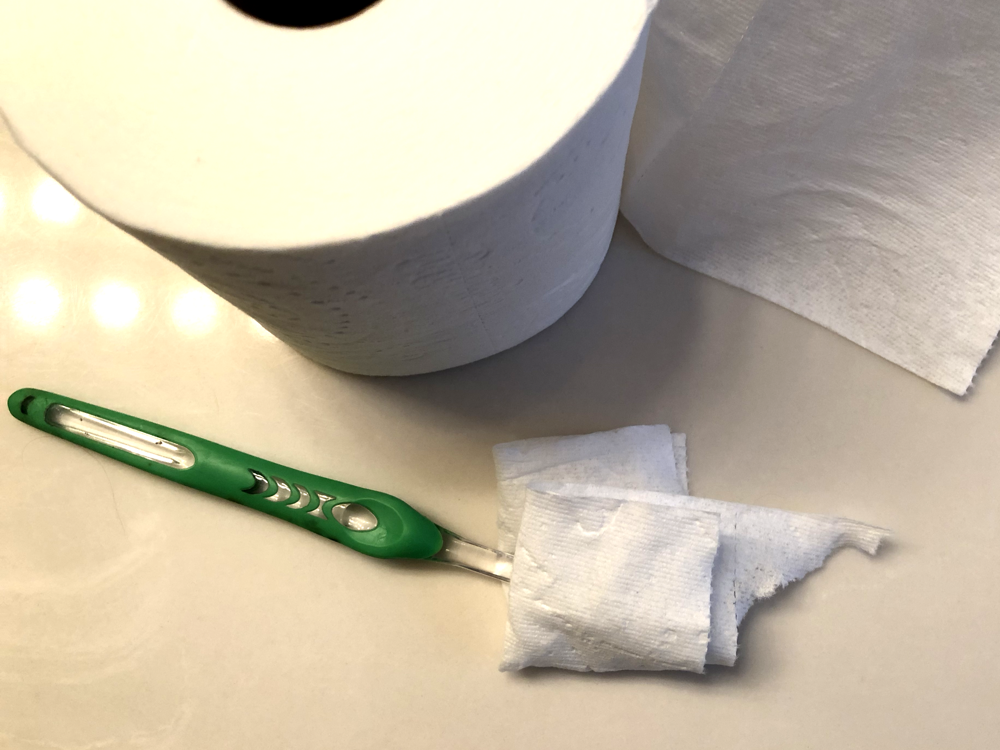
No. Not that economical. You’re going back to the whole idea of “things that should be in the toilet.” But at least you’re thinking dry.
The Toothbrush Shield
As a dental hygienist, at times I’ve been merely satisfied with knowing my patients are using a toothbrush, but lately I’ve decided to acknowledge that they can be vectors for pathogens to invade our bodies if not managed properly. What’s excessive though, is how there are all these UV blue-light sanitizers on the market and other expensive gadgets you really don’t need to keep your toothbrush healthy. Along that path, I discovered the one thing that actually makes a lot of sense:
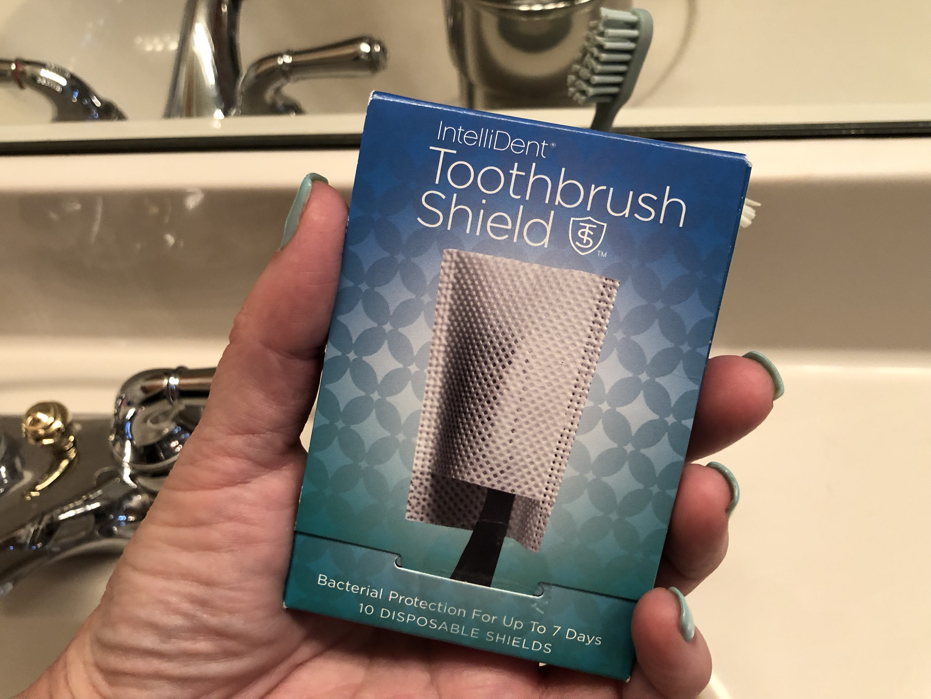
These covers both wick away moisture from your toothbrush and provide a physical barrier between your bristles and anything you don’t want them to touch, like your family’s other toothbrushes, bathroom cleaning chemicals, or stray hairs. I will never put my toothbrush in another plastic case now that I know about Toothbrush Shields.
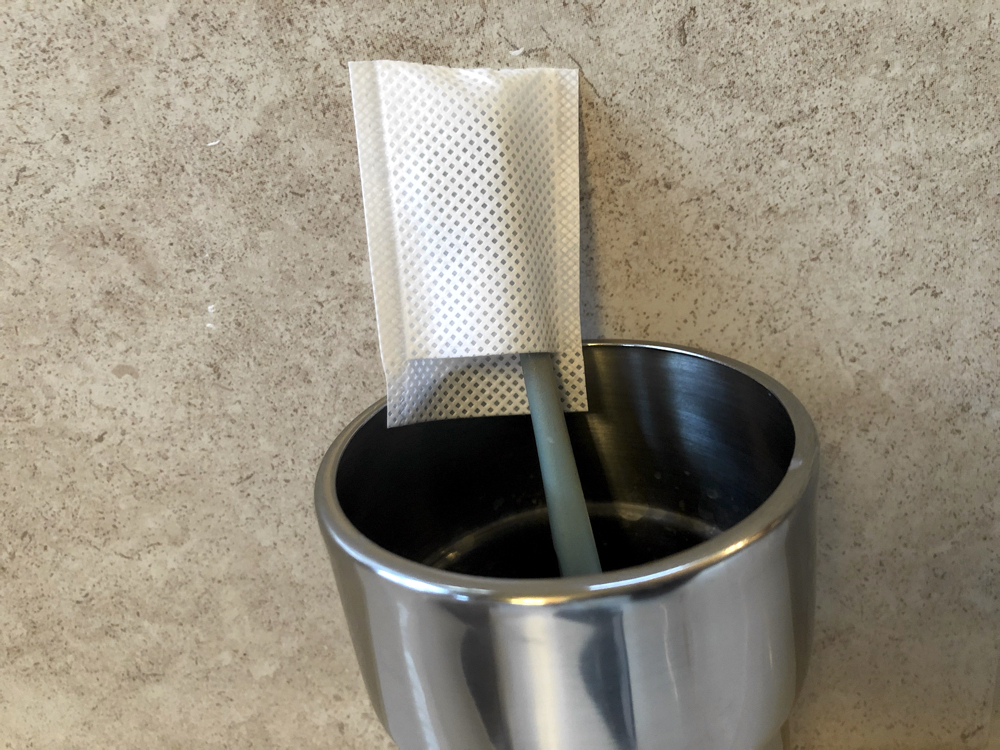
This product is so obvious that I’m surprised I’m just now finding out about it. I want to get the word out why wicking sleeves should be as universal to our lives as something like plastic baggies. This particular wicking sleeve is designed for your toothbrush, and here are the reasons why I am endorsing the Toothbrush Shield:
- Affordable. A pack of 10 Toothbrush Shields retails around $4.00 at the time of this writing, and each one is effective for up to 7 days.
- Simple to use. Slip the cover on right after brushing, then your toothbrush can go anywhere! Your bathroom counter, luggage, purse, kids’ backpacks for quick sleepovers. No fumbling for a way to protect toothbrushes from questionable environments.
- Hospital-grade. The lightweight but quality material feels almost identical to the larger sleeves I’ve used to keep saliva and blood off of patient headrests in the dental practice.
- Made in the USA. Not only that, the company is woman-owned.
Part of that last bullet point is how I found out about this product. In the United States, 97% of dental hygienists are women. Other than kindergarten teachers (see the 2018 Labor Statistics here), the rest of the professions aren’t even close to having this extreme gender skew. So a short time ago I was at a conference exclusively for the dental hygiene profession – for all these women, essentially – where I was given a few samples of the Toothbrush Shield. Mind you, I was carrying a trade show bag heavy with familiar toothpastes, flossers, mouthwashes, and brushes from all the dental hygiene exhibitors. But this one product stood out, especially since I’d never seen anything like it before.
That’s where the “woman-owned” part comes in. While the person who invented the Toothbrush Shield is not a dental hygienist by profession, she has the insight to realize where her biggest advocates are poised, and most importantly, who they are, and what drives them.

I’d like to introduce her to you. She is Susan Klinsport, an entrepreneur with a background ripe for solving the problem of germs and wet toothbrushes that she encountered in her personal life. Her experience working with engineering companies gained her the access to materials testing, scientific consultations, and manufacturing, and has resulted not only in the Toothbrush Shield, but she has also designed the larger version as a Mouthguard Shield.
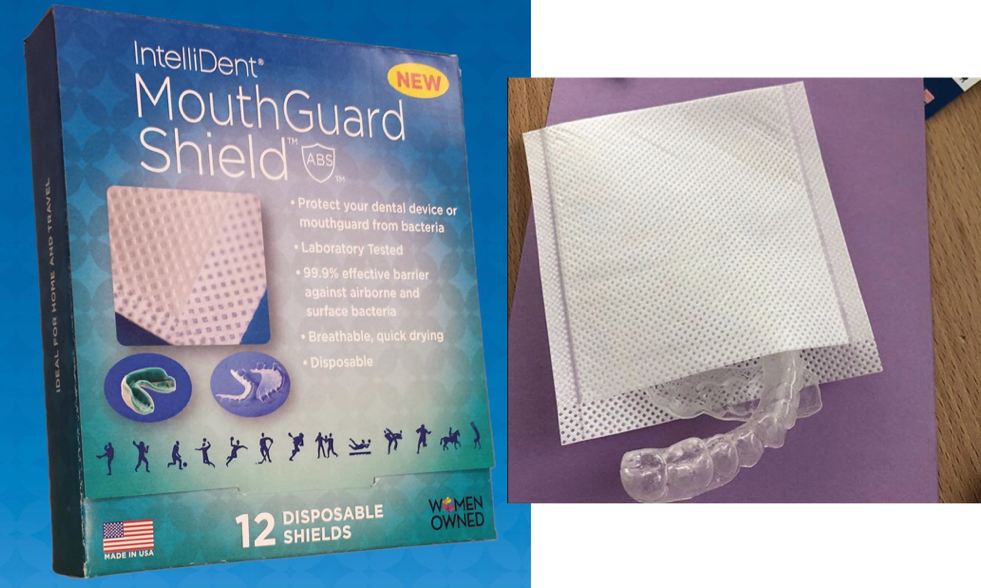
I didn’t snag any of these Mouthguard Shields at the conference, so I asked for some images from Susan herself. I know, right? She’s like totally my best friend now. That’s because after the show was over, I was like “Hey,” and she was like “What” and I emailed her to ask about her story and everything. And she was really cool about it so here we are, on DentalBuzz, getting the word out about a simple, effective product that will protect yours and your patients’ toothbrushes by keeping them covered every day, and that takes the place of plastic cases and rolled up toilet paper when traveling.
So where can you get Toothbrush Shields? Probably just down the street! You’ll find them in stock at CVS, Walmart, and Rite-Aid. Or if they’re not on your local pharmacy shelves, you can purchase online from many retailers, including the IntellidentProducts.com website that will take you to the Walgreens retail page where a box is on sale for $2.28 currently. Good deal! Even if they’re privately labeled, they are still the same product, as you can see below:
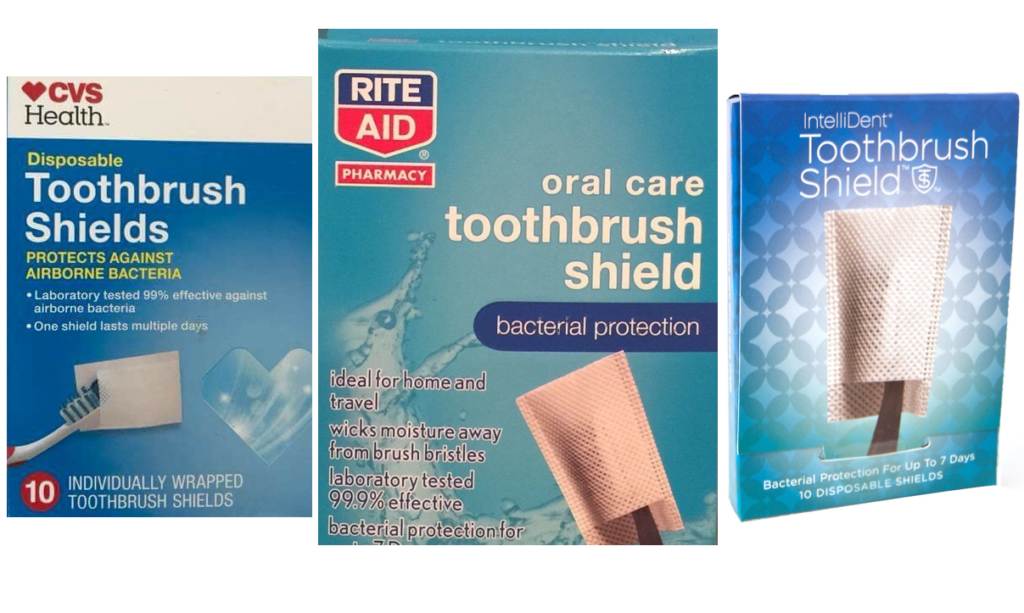
Critical Cleanliness
Patients undergoing cancer therapy are especially vulnerable to secondary infections, so oncology clinics and individuals are able to purchase Toothbrush Shields in bulk here on the website at SideEffectsSupport.com, the world’s leading resource for minimizing oral effects of cancer treatment. The shields are also included as part of the Oral Cancer Rescue Kit as pioneered by Jill Meyer-Lippert, RDH of SideEffectsSupport.com and Jennifer Brown, RDH, BS of CARTI Cancer Center in Arkansas.
Aetna has gotten the message as well. The insurance company is currently including the Toothbrush Shields in their oral hygiene care packages as part of their Rush to Brush program, thanks to the efforts of Susan Klinsport and Dian Baker, PhD RN. This program is designed to decrease patients’ risks of acquiring infections during hospital stays.
Final words
There is also a great news story featuring Susan and the Toothbrush Shield that I wanted to share here:
I’m now using the Toothbrush Shields over my manual toothbrush as well as my electric ones. Why so many brushes? It’s because I’m currently going back and forth, comparing my previously shelved Philips Sonicare with the new Braun OralB that I received for free from the same conference, but that’s a story for a future article. All have been easier to remember to re-cover, and I’m looking forward to traveling with them now instead of closed-in plastic caps that I have to keep up with.
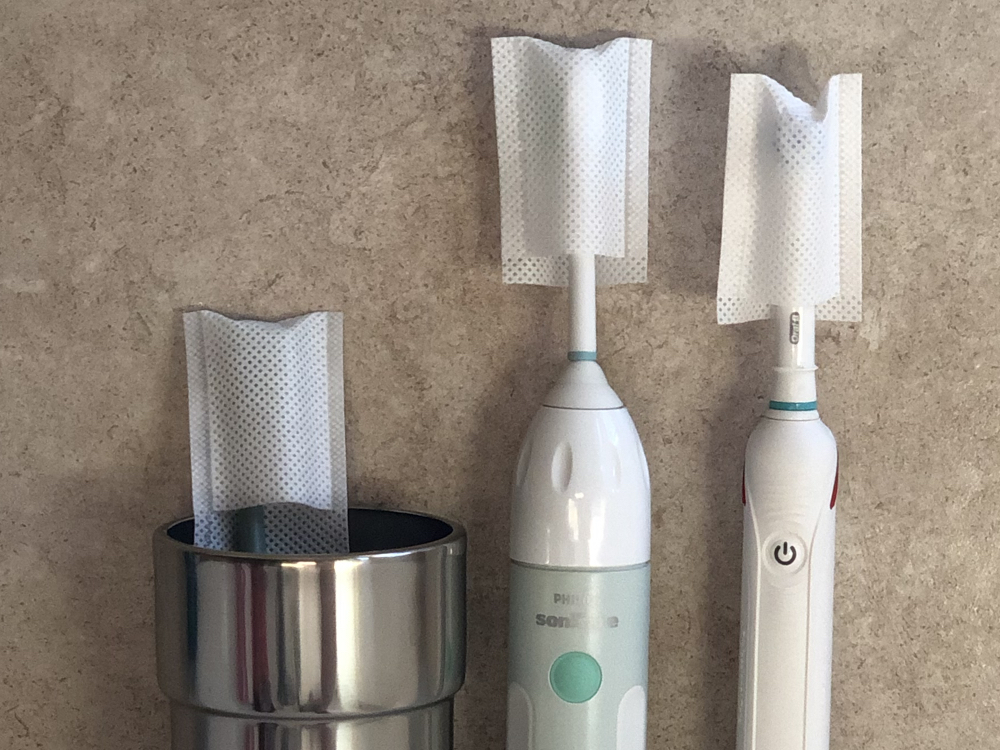
As for the toothbrush I threw in the toilet? It’s got a new job: scrubbing the dark grime out of the washing machine.


Trish Walraven RDH, BS has been curating DentalBuzz.com since 2008 as a casual place for dental professionals and their patients to explore dentistry in ways that make their lives better. This does not include firm toothbrushes, which is probably an equal factor for tossing that one that ended up in her laundry room.
Disclosure and copyright: Other than the samples, I did not receive any other form of compensation for this article. Feel free to share this information on your dental blogs, social media pages, or any habitats where patients and colleagues tend to dwell.
Resources and further reading:
https://www.allure.com/story/toothrbush-germs-bacteria
https://www.onhealth.com/content/1/toothbrush_germs_facts
https://www.guardiandirect.com/resources/articles/shocking-facts-about-your-toothbrush
Love it, great story!! Never even heard of these before, can’t wait to toss that bacteria container masquerading as a plastic travel case.
Hello, very interesting story about our protecting our tooth brush from harmful bacteria.